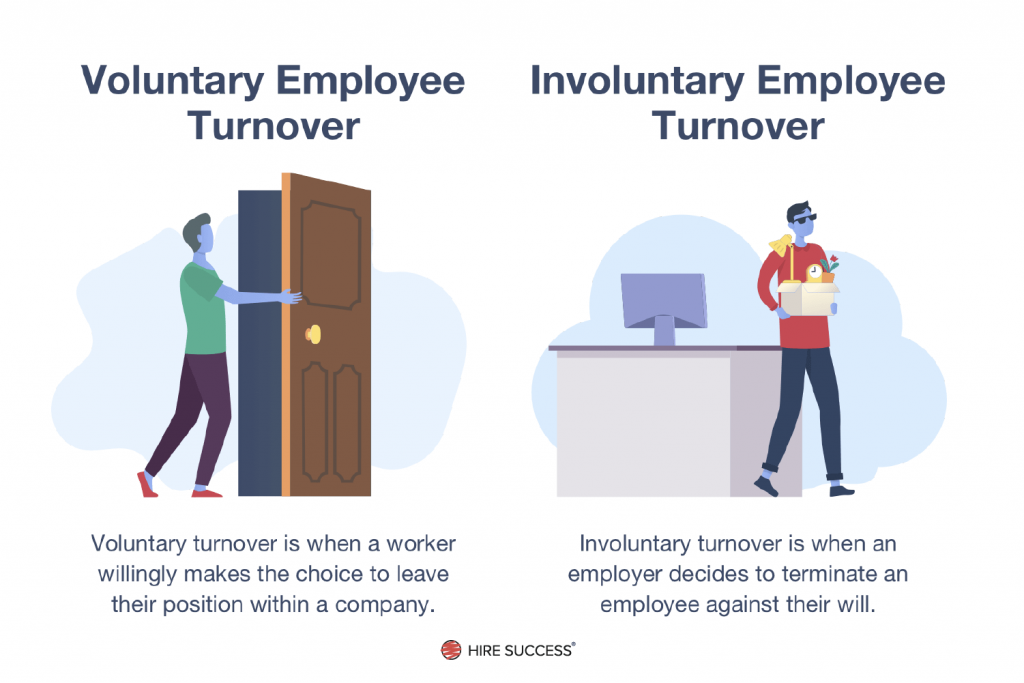The mastery of employee turnover and payroll management is essential in creating a stable, flourishing business environment. An investment in these areas can enhance employee satisfaction, maximize productivity, and secure the financial health of an organization.
Mismanagement of either aspect can spell disaster, affecting not just the people’s morale but also the company’s bottom line. And gone are the days when this was purely a human resources worry.
The health of a business is significantly tied to its management of employee turnover and payroll. An imbalance in either can lead to a ripple effect, impacting employee morale, productivity, and ultimately the organization’s profitability. Therefore, it’s vital to understand the complex correlation between employee turnover, payroll management, and overall business health.
Understanding employee turnover
Employee turnover is broadly classified into two categories — voluntary and involuntary.
Voluntary turnover occurs when an employee chooses to leave, whereas involuntary turnover results from a company’s decision to terminate an employment contract. Understanding the distinction between the two is a crucial first step in developing effective strategies to manage turnover.
Root causes of high employee turnover often stem from a combination of factors such as poor job satisfaction, lack of career progression, and unsatisfactory remuneration. Identifying and addressing these issues is the first step towards making strategic decisions that reduce turnover rates. Let’s explore some of the most common causes for voluntary and involuntary turnover.
Voluntary turnover causes
- Insufficient compensation: Employees may feel that their pay doesn’t match their role, work, responsibilities, or industry standards. This can prompt them to look for better-paying opportunities elsewhere.
- Lack of career growth: If employees perceive there’s a dead end in terms of career advancement within the company, they may choose to leave for opportunities that offer better prospects.
- Work-life imbalance: If the job demands excessive hours or the scheduling is unpredictable, it can lead to stress and dissatisfaction, prompting employees to quit.
- Poor management: Employees often leave managers, not companies. If there’s a lack of leadership, unfair treatment, or poor communication from management, it can cause employees to seek other jobs.
- Workplace culture: A negative or unsupportive workplace culture can lead to employee dissatisfaction and eventual departure.
Involuntary turnover causes
- Performance issues: Employees may be asked to leave if their performance doesn’t meet the company’s expectations or standards, despite training and support.
- Misconduct: Violation of company policies or unethical behavior can result in termination.
- Restructuring or downsizing: Sometimes, businesses may need to eliminate positions due to financial strain, merger, acquisition, or strategic change in business direction.
- Redundancy: If an employee’s role becomes obsolete due to technological advancements or changes in business needs, they might be let go.
- Contract expiration: In cases where people are hired for a specific project or a fixed period, they may be released once their contract ends and isn’t renewed.
The consequences of high staff turnover extend beyond mere financial cost. Operationally, frequent staffing changes can disrupt workflows and affect productivity. Culturally, it can erode team cohesion and employee morale, ultimately impairing the company’s ability to attract and retain talent.

Source: Hire Success
Measuring employee turnover rate in your company
Maintaining an optimal employee turnover rate is paramount for sustainable growth and profitability. This not only speaks to the overall health and environment of an organization but also greatly influences operational costs, productivity, and corporate image.
When companies maintain a balanced employee turnover rate, they stand to benefit in numerous ways. One of the primary advantages is improved employee morale. A stable workforce indicates a satisfied team, which contributes to a positive work culture and increased loyalty.
Next, there are significant reductions in hiring costs. Consistently replacing departing staff requires substantial financial outlays, not to mention the time and resources dedicated to training new people. Finally, aside from mainly human resources benefits, companies can enjoy increased productivity. A stable team can build upon shared experiences, collaborative efficiencies, and established workflows. EOR service providers, which often offer comprehensive HR solutions, can be instrumental in helping companies maintain a balanced employee turnover rate
Here are the Key Performance Indicators (KPIs) you should measure for effective turnover control:
- Turnover rate: This basic KPI tracks the percentage of people who leave the company over a set period, helping to gauge overall employee satisfaction.
- Cost per hire: A measure of the total expenses associated with hiring new employees, including advertising, recruitment, training, and onboarding costs.
- Time to fill: This metric gauges the average time it takes to fill a vacant work position, indicating the efficiency of the recruitment process.
- Payroll error rate: Monitoring discrepancies or mistakes in payroll can help companies ascertain the efficiency and accuracy of their payroll system.
- Employee satisfaction rate: Often gathered through employee surveys, this KPI reflects how satisfied, and by extension, engaged employees are with their jobs and the company.
- Overtime rate: A high overtime rate might indicate potential staffing issues or workload imbalances and can influence turnover if not managed.
Monitoring these KPIs regularly, and making necessary adjustments to operations, can significantly help companies maintain a healthy employee turnover rate and ensure a robust payroll system.
Proactive management of employee turnover
The strategic importance of job satisfaction can’t be overstated. A satisfied employee is less likely to seek opportunities elsewhere, thereby reducing turnover. Implementing policies that foster a supportive work environment is a pivotal step in enhancing job satisfaction and retaining employees. Such an atmosphere not only increases job satisfaction but also acts as a pillar in retaining employees. Employees thrive in environments where they feel their contributions are valued, and their well-being is a priority.
Effective work communication plays a significant role in managing employee turnover. Establishing robust feedback mechanisms allows people to voice their concerns, ideas, and suggestions. This two-way communication fosters a sense of belonging and can significantly enhance job satisfaction.
Another crucial aspect of managing your employee turnover rate proactively is career development and training opportunities. Employees are more likely to stay with a company that invests in their growth and offers avenues for advancement. Leveraging tools like an LMS system can help streamline this process, enhancing both skill development and employee loyalty..
Succession planning is about more than merely retaining employees; it’s about grooming them for leadership. Ensuring that there’s a pool of trained and capable individuals ready to step into key roles not only provides continuity for the organization but also serves as a motivating factor for employees. As they visualize a clear trajectory within the company, their commitment deepens. Additionally, as employees climb the ladder, they anticipate higher remuneration packages.
Employees that ascend to leadership roles should be offered competitive compensation packages commensurate with their new responsibilities. This clear linkage between career progression and salary increments can further motivate employees to stay.
In general, keeping pace with industry standards is vital. Companies should periodically review and adjust their pay scales, benefits, and perks to ensure they resonate with market trends and meet employee expectations. Comprehensive packages, inclusive of health benefits, retirement plans, and other incentives, are imperative for retaining top talent.
Recognizing and rewarding employee performance is an effective technique to manage turnover. Regular appreciation for good work goes a long way in boosting morale and cultivating a positive company culture. This can significantly contribute to lower staff turnover and a more committed workforce.
Payroll management: An employee retention catalyst
The structure of a company’s payroll system can significantly impact employee retention and labor turnover. Employees value a fair, transparent, and consistent payroll structure that adequately compensates them for their efforts. Therefore, exploring various payroll structures and their potential impact on employee retention can guide an organization’s payroll strategy.
Transparent and accurate payroll management is intrinsically linked to job satisfaction. Delays or inaccuracies in payroll can erode trust, demotivate employees, and even trigger voluntary turnover. Investing in a robust payroll management system can thus enhance job satisfaction and reduce the employee turnover rate.
Modern technological solutions significantly contribute to enhancing the robustness and efficiency of payroll management systems. The benefits lead to improved employee satisfaction and reduced turnover. Here are several ways technology can help create a robust payroll system:
- Automation: Technology enables the automation of payroll processes, reducing the time and effort needed to manually calculate wages, overtime, bonuses, and deductions. This not only simplifies the process but also minimizes the risk of human errors.
- Real-time data access: Payroll software can provide real-time access to data, making it easy to monitor and manage employee hours, absences, overtime, and compensation adjustments. This allows for prompt and accurate payroll processing.
- Compliance: Tech solutions can automatically update to reflect changes in local, state, or federal tax laws and regulations. This ensures that your payroll remains compliant, helping to avoid fines or penalties.
- Secure storage: Digital payroll systems offer secure storage of employee data, protecting sensitive information from unauthorized access, loss, or damage. This is crucial for maintaining trust with employees and adhering to data protection regulations.
- Direct deposit: With technology, companies can offer direct deposit, making payment quick, easy, and paperless. This not only enhances employee convenience but also contributes to eco-friendly business practices.
- Reporting: Payroll software often includes robust reporting features, providing insights into labor costs, overtime trends, employee compensation, and more. These reports can inform strategic business decisions.
- Integration: Many tech solutions can be integrated with other HR systems, like benefits management or time tracking software. This can streamline processes and improve data accuracy across multiple platforms.
Enhancing payroll processes through the adoption of modern systems, and ensuring timely payments, is crucial. Technological advancements can streamline payroll management, improve accuracy, and minimize the possibility of errors and delays — this enhancement can significantly boost employee satisfaction and contribute to labor turnover control.
Leveraging staff scheduling software for turnover control and improved efficiency
Effective scheduling is integral to reducing employee turnover and increasing job satisfaction. An equitable and predictable schedule can enhance work-life balance, resulting in happier, more satisfied employees who are less likely to leave the organization.
Implementing staff scheduling software can have a profound impact on managing and forecasting labor needs. Automating the scheduling process will likely optimize workforce distribution, minimize overtime, and increase work efficiency.
To ensure a successful implementation and utilization, certain best practices need to be followed:
- Understand your needs: Have a clear understanding of your business’s scheduling needs. Consider factors like peak hours, employee availability, and skills required for different shifts.
- Choose the right software: Not all scheduling software is created equal. Select a solution that aligns with your business size, industry, and specific needs. Look for features such as ease of use, mobile access, real-time updates, and integration capabilities.
- Comprehensive training: Ensure that all relevant employees, including managers and team leaders, are thoroughly trained on the new system. This should include both initial training and ongoing support as needed.
- Encourage employee participation: Involve employees in the scheduling process where possible. Allow them to set their availability, request time off, or swap shifts directly within your software for shift scheduling. This can boost their engagement and satisfaction.
- Monitor and adjust: Regularly monitor the effectiveness of the scheduling software and make adjustments as needed. Look at key metrics like overtime rates, employee satisfaction, and productivity levels.
- Maintain clear communication: Keep lines of communication open. Ensure employees are promptly notified of their schedules and any changes. The more transparent the process, the better the reception will be.
- Remain compliant: Ensure that your scheduling practices comply with all relevant labor laws and regulations, such as overtime rules or rest break requirements. The right software should support these compliance efforts.
- Use the reporting features: Most scheduling software will offer reporting features. Utilize these to gain insights into trends, potential bottlenecks, and areas for improvement.
Adhering to these best practices maximizes the benefits of staff scheduling software, leading to more efficient operations and happier, more engaged employees.
Conclusion
Integrating these strategies for effective employee turnover rate and payroll management can yield remarkable benefits for businesses. It can improve overall HR function, enhance employee satisfaction, and secure the financial health of the company.
The world of HR is continuously evolving, presenting new opportunities in employee turnover and payroll management. Staying ahead of these trends and leveraging them effectively is a critical part of any successful business strategy. This proactive approach can help businesses retain their top people, improve operational efficiency, and drive their growth and success in the long run.

.png)





I never took into account the fact that employee retention can actually be affected by the structure of your company’s payroll system. In that case, companies should probably invest in experts in that industry in order to make everything easier and faster as well as prevent errors. Anything that is related to money and salary should definitely be done correctly because it can even lead to lawsuits or legal problems if there are problems that are not resolved as soon as possible.
Hi Mia, you’re absolutely right about the importance of a company’s payroll system in employee retention. Efficient, error-free payroll processing is crucial, not just for employee satisfaction, but also for legal compliance.
No company is bad, it’s all about under whom we are associated. Because, some bosses try to miss use their administrative power on their subordinates, which is really very bad. That is the reason, most the employees always change their current company.
Hi Joy, you make a valid point. The work environment and leadership style can greatly impact employee satisfaction. A positive work culture is key for retention. Thank you for sharing your thought!